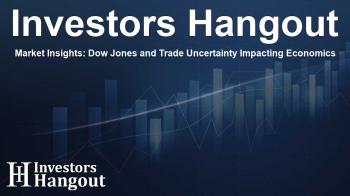Market Insights: Dow Jones and Trade Uncertainty Impacting Economics

Understanding the Current Market Dynamics
The Dow Jones Industrial Average finds itself at a pivotal moment, navigating the tumultuous waters of political discourse and economic signals that seem to pull in conflicting directions. Recently, the Dow approached a significant milestone, almost reaching the 45,000-point threshold, only to slide back towards 44,350. This fluctuation showcases a clear indication of waning momentum within the market.
Political Influences on Economic Stability
Political factors have taken center stage, particularly with the recent announcement of tariffs that have significant trade implications. With a renewed vigor, the administration has introduced a 25% tariff on Japanese imports and an additional 25% levy on goods from South Korea, with stark warnings directed at several nations to streamline trade agreements promptly. This cascade of announcements added a layer of tension to the already volatile market.
The Surprising Tariffs and Their Implications
Unlike previous trade announcements that were often met with investor hesitance, this time, the market's response was notably muted. Investors may be becoming desensitized to such rhetoric or possibly recalling the past instances where deadlines were extended without significant action. The pivotal moment came when a startling 50% tariff was imposed on copper imports from the U.S., taking effect immediately. This unexpected declaration has the potential to set a precedent for similar actions with other commodities, stirring a mix of concern and speculation among market participants.
Market Technicals and Future Outlook
Delving into technical analysis reveals that while the Dow remains confidently above its 200-day moving average, the ongoing struggle to breach the 45,000-point resistance level, combined with momentum indicators nearing overbought conditions, suggests that market participants are increasingly vigilant. This current state of affairs may signal a shift in how traders perceive risk versus reward.
The Federal Reserve's Stance
Simultaneously, the Federal Reserve appears to be in a “wait-and-see” mode, with investors eagerly anticipating insights from upcoming FOMC minutes. Following a recent jobs report that highlighted resilience in the labor market, expectations regarding potential rate cuts are being carefully reassessed. Current tools indicate that any forthcoming rate reductions could be delayed until later in the year.
Challenges in the Bigger Picture
When stepping back to analyze the broader market landscape, it’s clear that uncertainty looms large. The ongoing efforts to reshape global trade relationships clash with the central bank's attempts to balance between managing inflation and fostering risk appetite among investors. This creates a complex scenario where individuals are trying to make sense of the narrative before significant comments or announcements change the landscape.
Cautious Investor Behavior
The recent downturn in the Dow may not be a mere technical correction; instead, it reflects a deeper sentiment of cautious positioning among investors. While liquidity continues to flow into the market, participants are opting for more selective strategies. This has resulted in a balance, as no one is aggressively divesting, but neither are they pursuing purchases without due diligence.
The Smart Pause: An Investor's Perspective
In trading parlance, this could exemplify what is being termed as “the smart pause.” Investors remain in a holding pattern, carefully watching for a decisive break above the crucial resistance levels or a retreat towards more favorable demand positions. Regardless of the direction, the Dow remains closely monitored by traders and analysts alike.
Frequently Asked Questions
What recent political events have influenced the Dow Jones?
Recent announcements of tariffs on goods from Japan and South Korea have created uncertainties in the market, causing fluctuations in the Dow Jones.
How does the tariff on copper imports affect the market?
The 50% tariff on U.S. copper imports is seen as an alarming precedent that could affect other commodities as well, stirring market reactions.
What is the current stance of the Federal Reserve?
The Federal Reserve is currently in a cautious stance, observing market conditions before making decisions on potential rate cuts.
Why is investor sentiment described as cautious?
Investors are taking a measured approach, avoiding aggressive buying or selling while waiting for clearer market signals.
What does the term 'smart pause' mean in trading?
'Smart pause' refers to a strategic holding pattern where traders refrain from making impulsive decisions, opting instead to wait for more favorable conditions.
About The Author
Contact Kelly Martin privately here. Or send an email with ATTN: Kelly Martin as the subject to contact@investorshangout.com.
About Investors Hangout
Investors Hangout is a leading online stock forum for financial discussion and learning, offering a wide range of free tools and resources. It draws in traders of all levels, who exchange market knowledge, investigate trading tactics, and keep an eye on industry developments in real time. Featuring financial articles, stock message boards, quotes, charts, company profiles, and live news updates. Through cooperative learning and a wealth of informational resources, it helps users from novices creating their first portfolios to experts honing their techniques. Join Investors Hangout today: https://investorshangout.com/
The content of this article is based on factual, publicly available information and does not represent legal, financial, or investment advice. Investors Hangout does not offer financial advice, and the author is not a licensed financial advisor. Consult a qualified advisor before making any financial or investment decisions based on this article. This article should not be considered advice to purchase, sell, or hold any securities or other investments. If any of the material provided here is inaccurate, please contact us for corrections.

